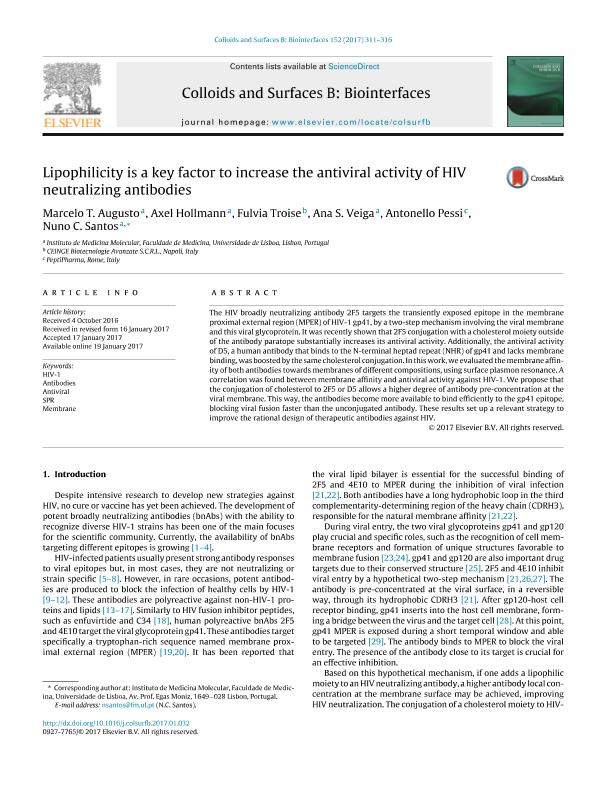Mostrar el registro sencillo del ítem
dc.contributor.author
Augusto, Marcelo T.

dc.contributor.author
Hollmann, Axel

dc.contributor.author
Troise, Fulvia
dc.contributor.author
Veiga, Ana S.
dc.contributor.author
Pessi, Antonello
dc.contributor.author
Santos, Nuno C.
dc.date.available
2018-07-25T14:33:15Z
dc.date.issued
2017-04
dc.identifier.citation
Augusto, Marcelo T.; Hollmann, Axel; Troise, Fulvia; Veiga, Ana S.; Pessi, Antonello; et al.; Lipophilicity is a key factor to increase the antiviral activity of HIV neutralizing antibodies; Elsevier Science; Colloids and Surfaces B: Biointerfaces; 152; 4-2017; 311-316
dc.identifier.issn
0927-7765
dc.identifier.uri
http://hdl.handle.net/11336/53065
dc.description.abstract
The HIV broadly neutralizing antibody 2F5 targets the transiently exposed epitope in the membrane proximal external region (MPER) of HIV-1 gp41, by a two-step mechanism involving the viral membrane and this viral glycoprotein. It was recently shown that 2F5 conjugation with a cholesterol moiety outside of the antibody paratope substantially increases its antiviral activity. Additionally, the antiviral activity of D5, a human antibody that binds to the N-terminal heptad repeat (NHR) of gp41 and lacks membrane binding, was boosted by the same cholesterol conjugation. In this work, we evaluated the membrane affinity of both antibodies towards membranes of different compositions, using surface plasmon resonance. A correlation was found between membrane affinity and antiviral activity against HIV-1. We propose that the conjugation of cholesterol to 2F5 or D5 allows a higher degree of antibody pre-concentration at the viral membrane. This way, the antibodies become more available to bind efficiently to the gp41 epitope, blocking viral fusion faster than the unconjugated antibody. These results set up a relevant strategy to improve the rational design of therapeutic antibodies against HIV.
dc.format
application/pdf
dc.language.iso
eng
dc.publisher
Elsevier Science

dc.rights
info:eu-repo/semantics/openAccess
dc.rights.uri
https://creativecommons.org/licenses/by-nc-sa/2.5/ar/
dc.subject
Antibodies
dc.subject
Antiviral
dc.subject
Hiv-1
dc.subject
Membrane
dc.subject
Spr
dc.subject.classification
Otras Ciencias Biológicas

dc.subject.classification
Ciencias Biológicas

dc.subject.classification
CIENCIAS NATURALES Y EXACTAS

dc.title
Lipophilicity is a key factor to increase the antiviral activity of HIV neutralizing antibodies
dc.type
info:eu-repo/semantics/article
dc.type
info:ar-repo/semantics/artículo
dc.type
info:eu-repo/semantics/publishedVersion
dc.date.updated
2018-07-25T13:51:36Z
dc.journal.volume
152
dc.journal.pagination
311-316
dc.journal.pais
Países Bajos

dc.journal.ciudad
Amsterdam
dc.description.fil
Fil: Augusto, Marcelo T.. Universidade de Lisboa; Portugal
dc.description.fil
Fil: Hollmann, Axel. Consejo Nacional de Investigaciones Científicas y Técnicas; Argentina. Universidade de Lisboa; Portugal
dc.description.fil
Fil: Troise, Fulvia. CEINGE Biotecnologie Avanzate S.C.R.L; Italia
dc.description.fil
Fil: Veiga, Ana S.. Universidade de Lisboa; Portugal
dc.description.fil
Fil: Pessi, Antonello. PeptiPharma; Italia
dc.description.fil
Fil: Santos, Nuno C.. Universidade de Lisboa; Portugal
dc.journal.title
Colloids and Surfaces B: Biointerfaces

dc.relation.alternativeid
info:eu-repo/semantics/altIdentifier/doi/https://dx.doi.org/10.1016/j.colsurfb.2017.01.032
dc.relation.alternativeid
info:eu-repo/semantics/altIdentifier/url/https://www.sciencedirect.com/science/article/pii/S0927776517300413
Archivos asociados
